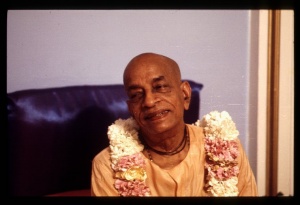SB 2.6.22: Difference between revisions
No edit summary |
(Vanibot #0054 edit - transform synonyms into clickable links, which search similar occurrences) |
||
| Line 23: | Line 23: | ||
<div class="synonyms"> | <div class="synonyms"> | ||
''yasmāt'' | ''[//vanipedia.org/wiki/Special:VaniSearch?s=yasmāt&tab=syno_o&ds=1 yasmāt]'' — from whom; ''[//vanipedia.org/wiki/Special:VaniSearch?s=aṇḍam&tab=syno_o&ds=1 aṇḍam]'' — the universal globes; ''[//vanipedia.org/wiki/Special:VaniSearch?s=virāṭ&tab=syno_o&ds=1 virāṭ]'' — and the gigantic universal form; ''[//vanipedia.org/wiki/Special:VaniSearch?s=jajñe&tab=syno_o&ds=1 jajñe]'' — appeared; ''[//vanipedia.org/wiki/Special:VaniSearch?s=bhūta&tab=syno_o&ds=1 bhūta]'' — elements; ''[//vanipedia.org/wiki/Special:VaniSearch?s=indriya&tab=syno_o&ds=1 indriya]'' — senses; ''[//vanipedia.org/wiki/Special:VaniSearch?s=guṇa&tab=syno_o&ds=1 guṇa]-[//vanipedia.org/wiki/Special:VaniSearch?s=ātmakaḥ&tab=syno_o&ds=1 ātmakaḥ]'' — qualitative; ''[//vanipedia.org/wiki/Special:VaniSearch?s=tat&tab=syno_o&ds=1 tat] [//vanipedia.org/wiki/Special:VaniSearch?s=dravyam&tab=syno_o&ds=1 dravyam]'' — the universes and the universal form, etc.; ''[//vanipedia.org/wiki/Special:VaniSearch?s=atyagāt&tab=syno_o&ds=1 atyagāt]'' — surpassed; ''[//vanipedia.org/wiki/Special:VaniSearch?s=viśvam&tab=syno_o&ds=1 viśvam]'' — all the universes; ''[//vanipedia.org/wiki/Special:VaniSearch?s=gobhiḥ&tab=syno_o&ds=1 gobhiḥ]'' — by the rays; ''[//vanipedia.org/wiki/Special:VaniSearch?s=sūryaḥ&tab=syno_o&ds=1 sūryaḥ]'' — the sun; ''[//vanipedia.org/wiki/Special:VaniSearch?s=iva&tab=syno_o&ds=1 iva]'' — like; ''[//vanipedia.org/wiki/Special:VaniSearch?s=ātapan&tab=syno_o&ds=1 ātapan]'' — distributed rays and heat. | ||
</div> | </div> | ||
Latest revision as of 21:18, 17 February 2024

A.C. Bhaktivedanta Swami Prabhupada
TEXT 22
- yasmād aṇḍaṁ virāḍ jajñe
- bhūtendriya-guṇātmakaḥ
- tad dravyam atyagād viśvaṁ
- gobhiḥ sūrya ivātapan
SYNONYMS
yasmāt — from whom; aṇḍam — the universal globes; virāṭ — and the gigantic universal form; jajñe — appeared; bhūta — elements; indriya — senses; guṇa-ātmakaḥ — qualitative; tat dravyam — the universes and the universal form, etc.; atyagāt — surpassed; viśvam — all the universes; gobhiḥ — by the rays; sūryaḥ — the sun; iva — like; ātapan — distributed rays and heat.
TRANSLATION
From that Personality of Godhead, all the universal globes and the universal form with all material elements, qualities and senses are generated. Yet He is aloof from such material manifestations, like the sun, which is separate from its rays and heat.
PURPORT
The supreme truth has been ascertained in the previous verse as puruṣa or the puruṣottama, the Supreme person. The Absolute person is the īśvara, or the supreme controller, by His different energies. The ekapād-vibhūti manifestation of the material energy of the Lord is just like one of the many mistresses of the Lord, by whom the Lord is not so much attracted, as indicated in the language of the Gītā (bhinnā prakṛtiḥ). But the region of the tripād-vibhūti, being a pure spiritual manifestation of the energy of the Lord, is, so to speak, more attractive to Him. The Lord, therefore, generates the material manifestations by impregnating the material energy, and then, within the manifestation, He expands Himself as the gigantic form of the viśva-rūpa. The viśva-rūpa, as it was shown to Arjuna, is not the original form of the Lord. The original form of the Lord is the transcendental form of Puruṣottama, or Kṛṣṇa Himself. It is very nicely explained herein that He expands Himself just like the sun. The sun expands itself by its terrible heat and rays, yet the sun is always aloof from such rays and heat. The impersonalist takes into consideration the rays of the Lord without any information of the tangible, transcendental, eternal form of the Lord, known as Kṛṣṇa. Therefore Kṛṣṇa, in His supreme personal form, with two hands and flute, is bewildering for the impersonalists who can accommodate only the gigantic viśva-rūpa of the Lord. They should know that the rays of the sun are secondary to the sun, and similarly the impersonal gigantic form of the Lord is also secondary to the personal form as Puruṣottama. The Brahma-saṁhitā (BS 5.38) confirms this statement as follows:
- ānanda-cinmaya-rasa-pratibhāvitābhis
- tābhir ya eva nija-rūpatayā kalābhiḥ
- goloka eva nivasaty akhilātma-bhūto
- govindam ādi-puruṣaṁ tam ahaṁ bhajāmi
"The Supreme Personality of Godhead, Govinda, the one who enlivens the senses of everyone by His personal bodily rays, resides in His transcendental abode, called Goloka. Yet He is present in every nook and corner of His creation by expansion of happy spiritual rays, equal in power to His personal potency of bliss." He is therefore simultaneously personal and impersonal by His inconceivable potency, or He is the one without a second, displaying complete unity in a diversity of material and spiritual manifestations. He is separate from everything, and still nothing is different from Him.